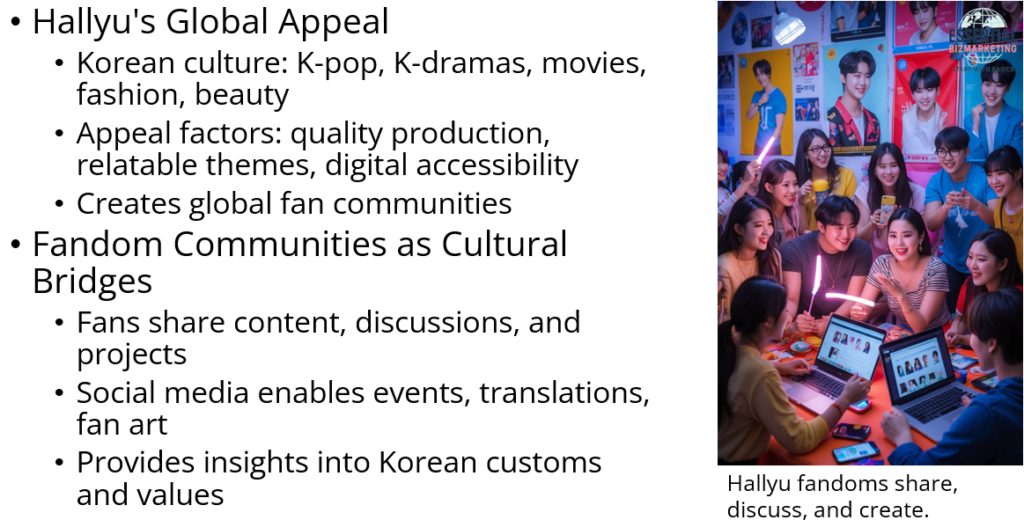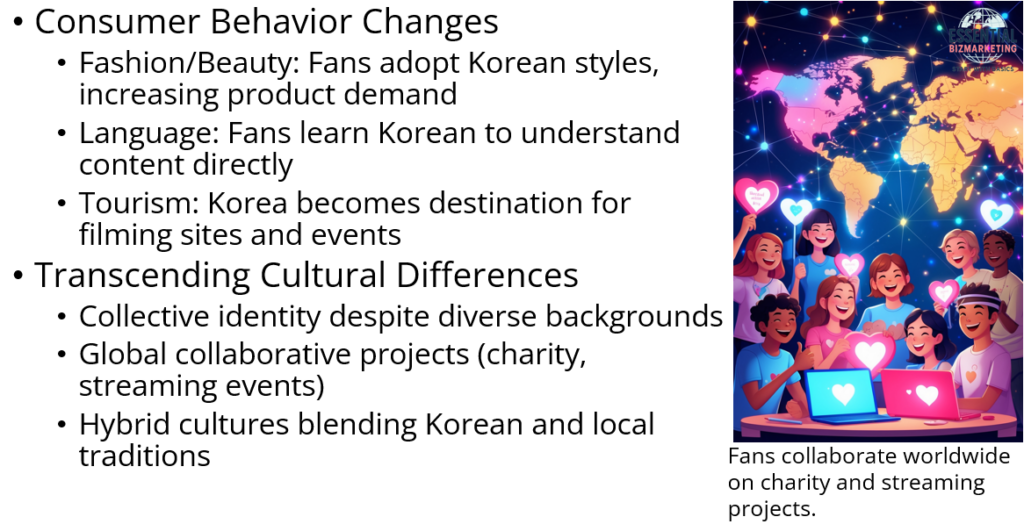The Korean Wave, or Hallyu, has evolved into a global phenomenon, significantly impacting consumer behavior across diverse cultures. This exploration delves into how Hallyu fandom culture enables consumers worldwide to transcend cultural differences and engage deeply with Korean content.
The Rise of Hallyu and Its Global Appeal

Hallyu encompasses various facets of Korean culture, including music (K-pop), television dramas (K-dramas), movies, fashion, and beauty products. Its global appeal can be attributed to high-quality production, relatable themes, and the strategic use of digital platforms that facilitate easy access to content. This widespread accessibility has allowed diverse audiences to connect with Korean culture, fostering a global community of fans.
Fandom Communities as Cultural Bridges
Hallyu fandoms operate as vibrant communities where fans share content, discuss narratives, and participate in fan-driven projects. These communities often utilize social media platforms to organize events, share translations, and create fan art, effectively bridging cultural gaps. Through active participation, fans gain insights into Korean customs, language, and societal values, leading to a more profound appreciation and understanding of the culture.
Consumer Behavior Influenced by Hallyu

The influence of Hallyu extends beyond entertainment, significantly affecting global consumer behavior:
- Fashion and Beauty: Fans often emulate the styles of their favorite Korean celebrities, leading to increased demand for Korean fashion and beauty products. This trend has propelled Korean brands onto the international stage, with consumers seeking authenticity in their purchases.
- Language Learning: Motivated by a desire to understand lyrics and dialogues without translation, many fans embark on learning the Korean language. This pursuit enhances their connection to the content and reflects a commitment to cultural immersion.
- Travel and Tourism: Korea has become a popular destination for fans wishing to experience the culture firsthand. Tourists often visit filming locations, attend concerts, and participate in cultural festivals, contributing to the local economy.
Overcoming Cultural Differences
Hallyu fandoms exemplify how cultural differences can be transcended through shared interests:
- Collective Identity: Despite diverse backgrounds, fans identify collectively as part of the Hallyu community. This shared identity fosters inclusivity and diminishes cultural barriers.
- Collaborative Projects: Fans collaborate on global projects, such as charity drives and streaming parties, showcasing a unified effort that transcends geographical boundaries.
- Adaptation and Integration: Local fan clubs often integrate Korean cultural elements with their own traditions, creating a hybrid culture that respects both Korean origins and local customs.
Impact on Global Markets

The global reach of Hallyu has prompted international brands to adapt their strategies:
- Product Localization: Brands incorporate Korean elements into their products to appeal to Hallyu fans, blending local preferences with Korean aesthetics.
- Collaborations with Korean Artists: International companies collaborate with Korean celebrities for endorsements, leveraging their global influence to reach a broader audience.
Conclusion
Hallyu fandom culture demonstrates the power of shared interests in bridging cultural divides. By engaging with Korean content, global consumers not only embrace new cultural experiences but also influence market trends and foster international unity. This phenomenon underscores the potential of entertainment media as a catalyst for cultural exchange and global consumer integration.
📚 References
Cho, Y. (2020). A study on the cultural-political implications of the overseas acceptance culture of K-pop. Journal of Communication Research, 57(1), 33-63. Retrieved from https://journal.comm.or.kr/xml/30824/30824.pdf
Lee, J. (2018). Analysis of differences in K-pop concert experience factors (4Es) and leisure satisfaction: Focusing on companions and viewing frequency. Korean Journal of Leisure, Recreation & Park, 42(4), 61-74. Retrieved from https://journal.kslrp.net/xml/23620/23620.pdf
Kim, H. (2021). Localization and indigenization of K-pop: A case study of SB19 in the Philippines. Master’s thesis, Seoul National University. Retrieved from https://s-space.snu.ac.kr/bitstream/10371/193950/1/000000176683.pdf
📁 Start exploring the Blog
📘 Or learn more About this site
🧵 Or follow along on X (Twitter)
🔎 Looking for sharp perspectives on global trade and markets?
I recommend @GONOGO_Korea as a resource I trust and regularly learn from.
